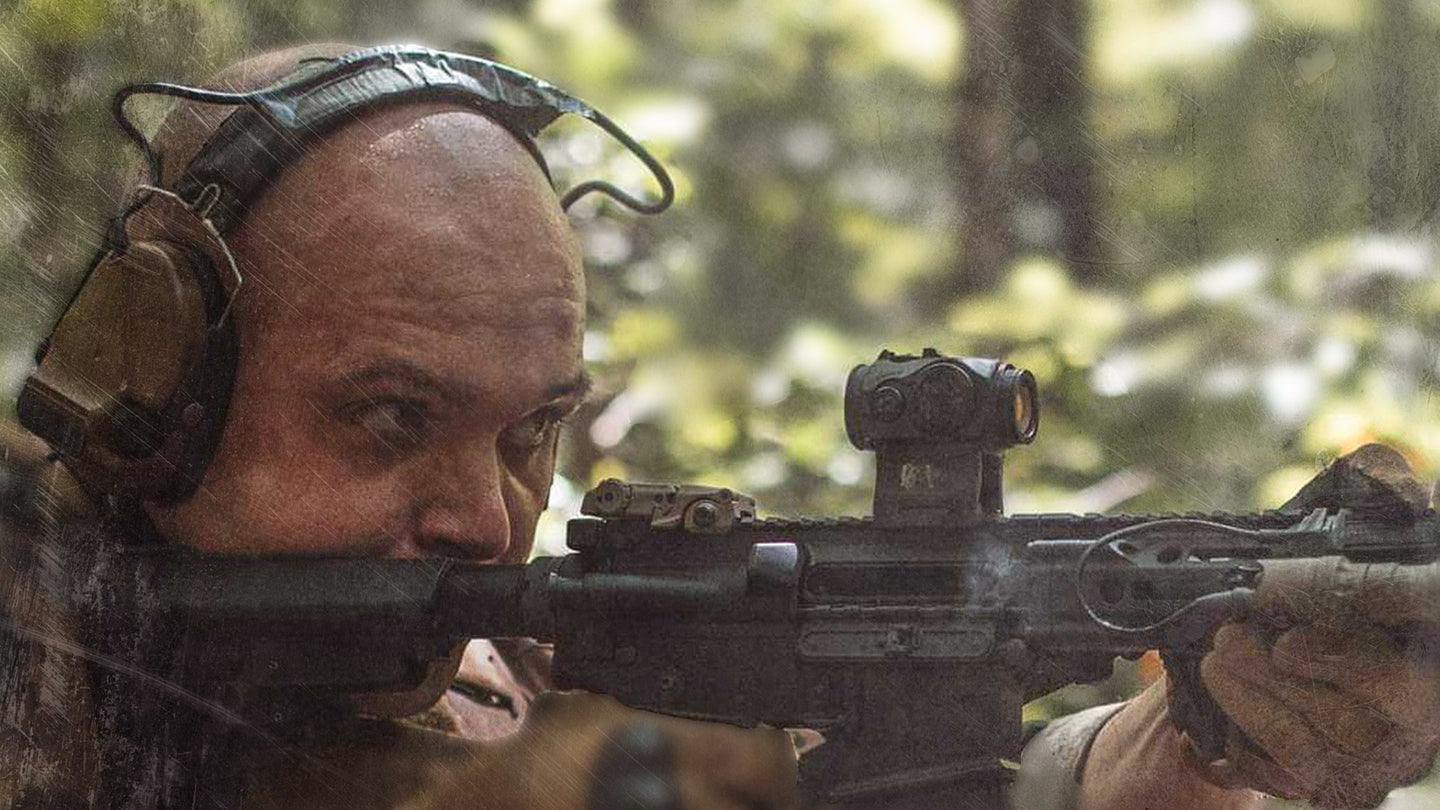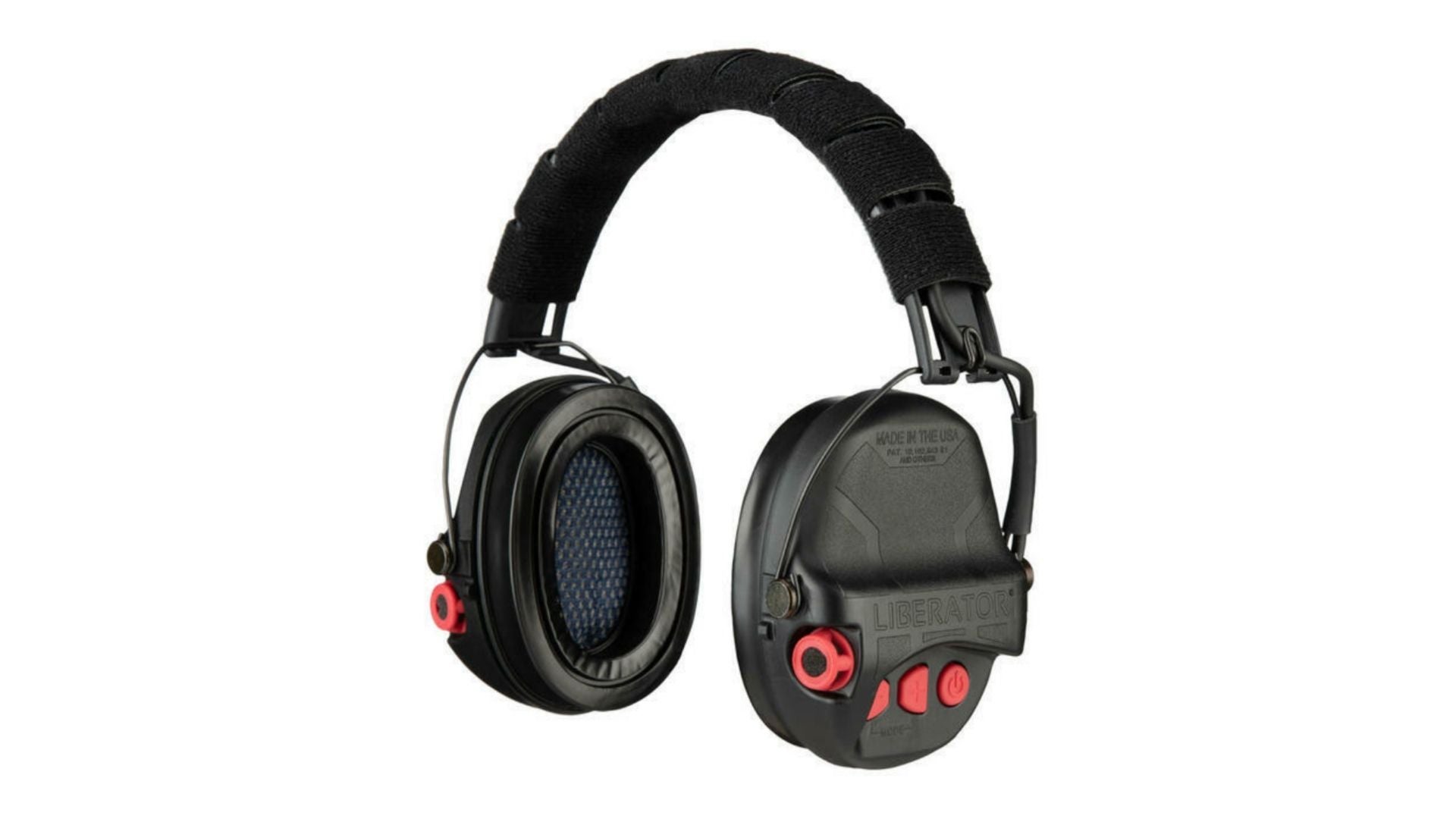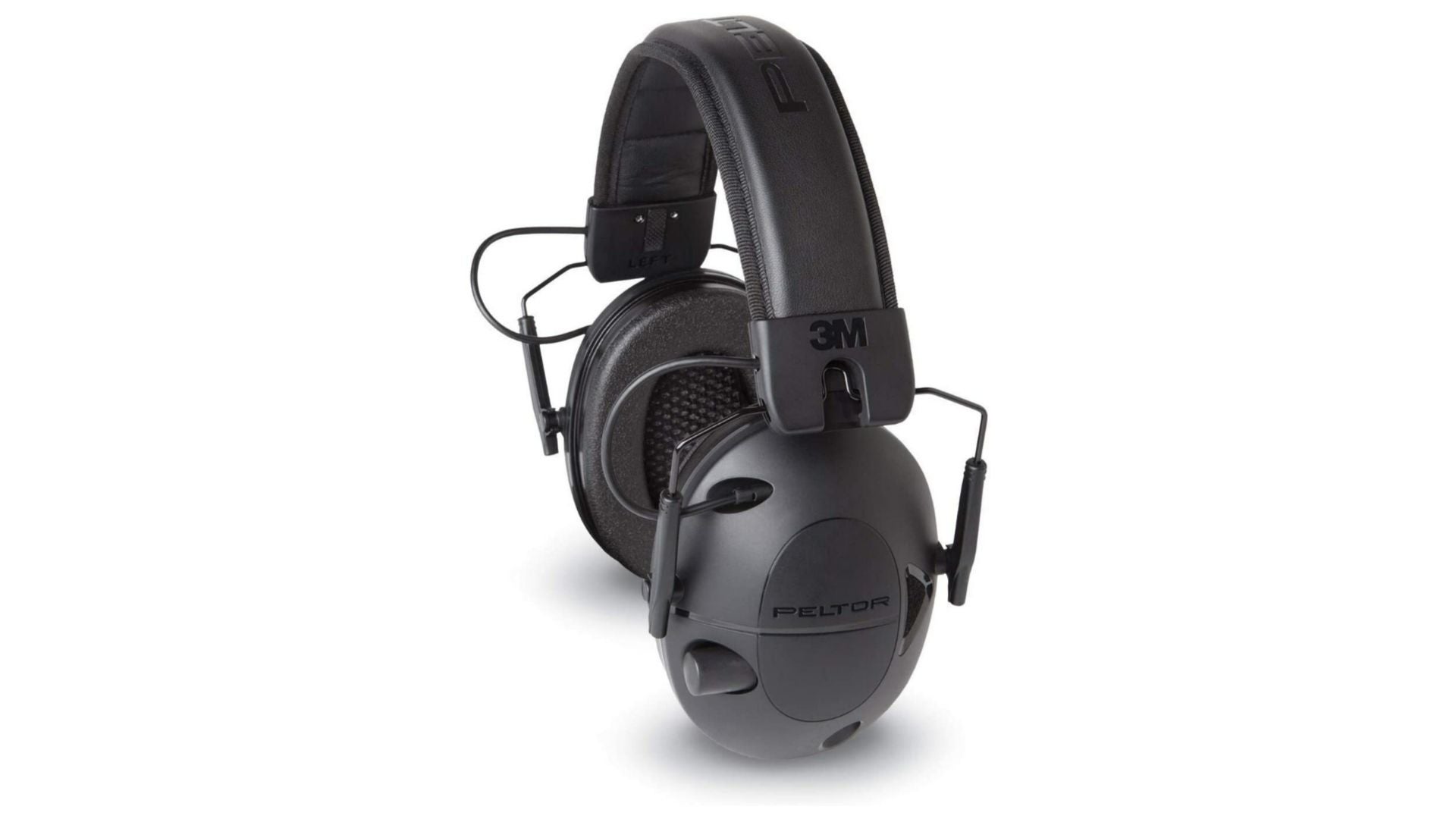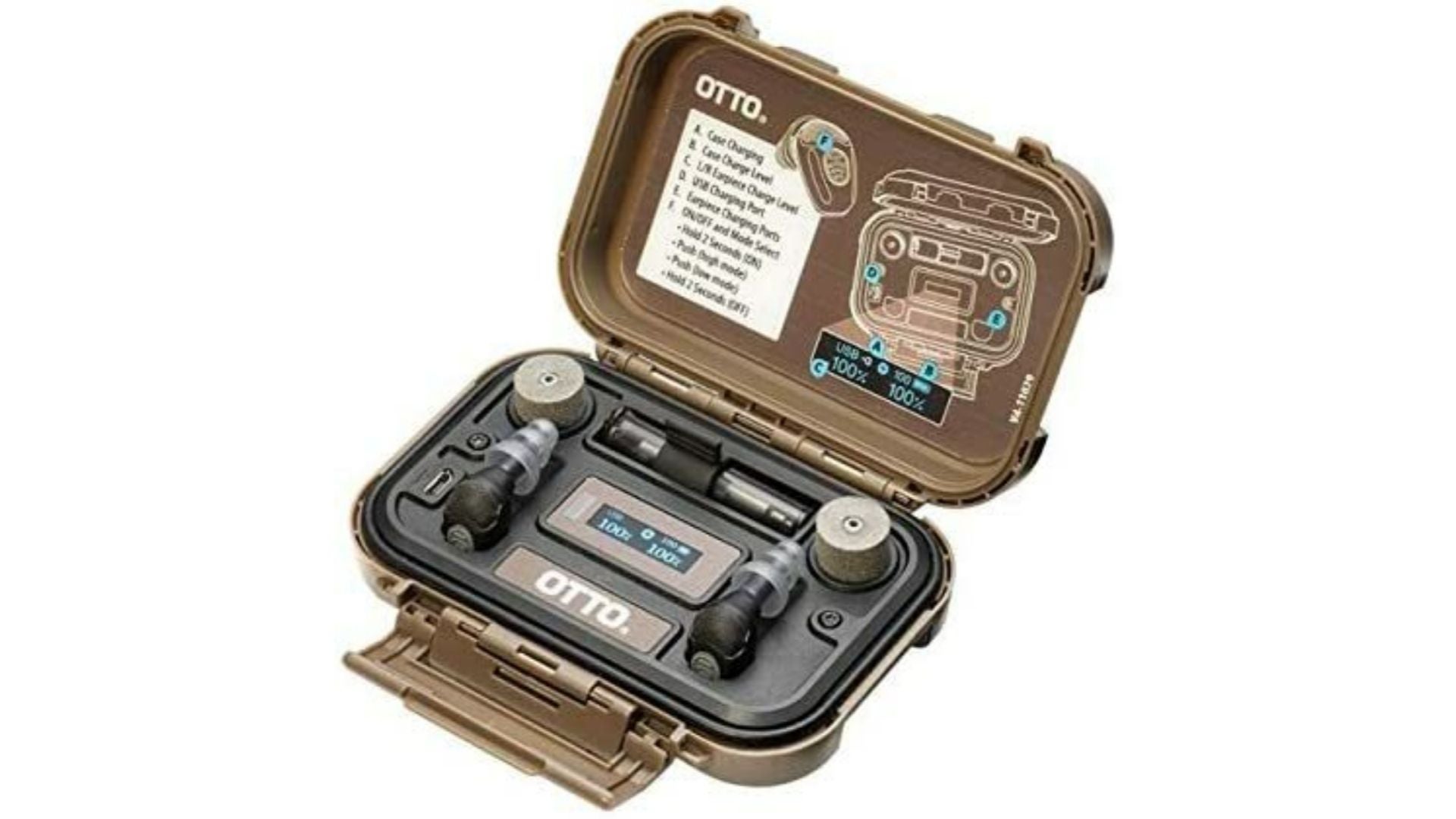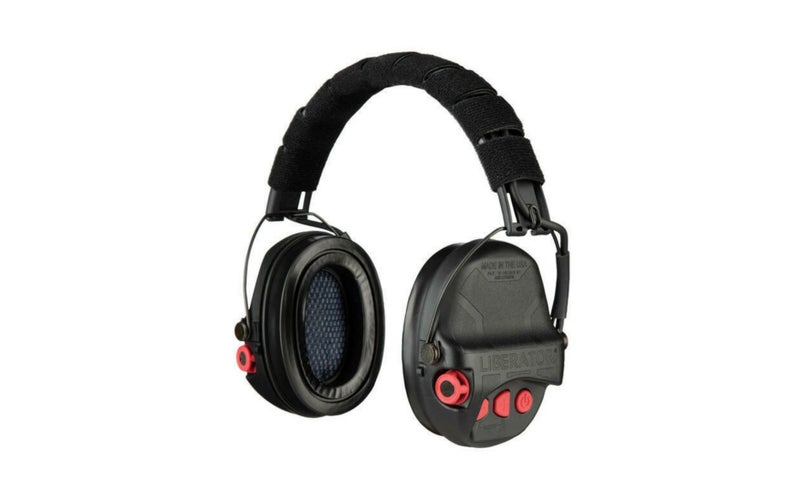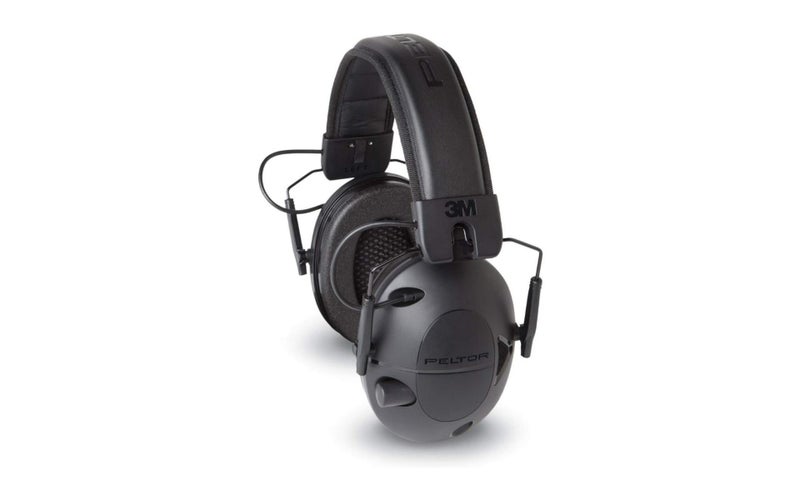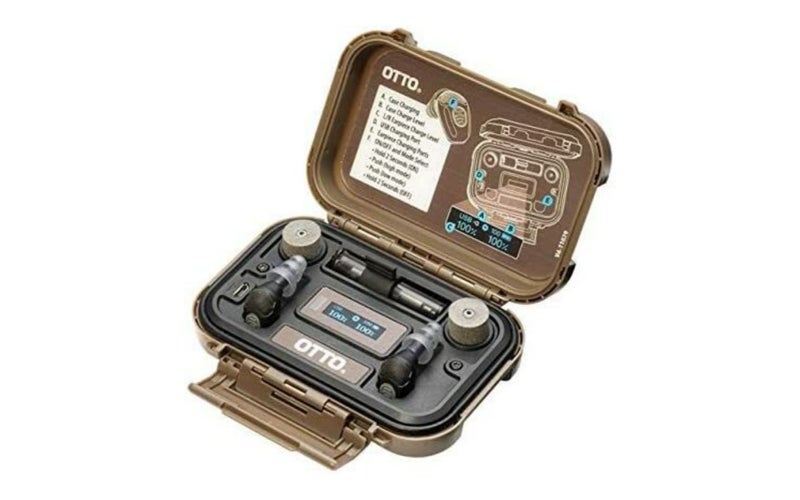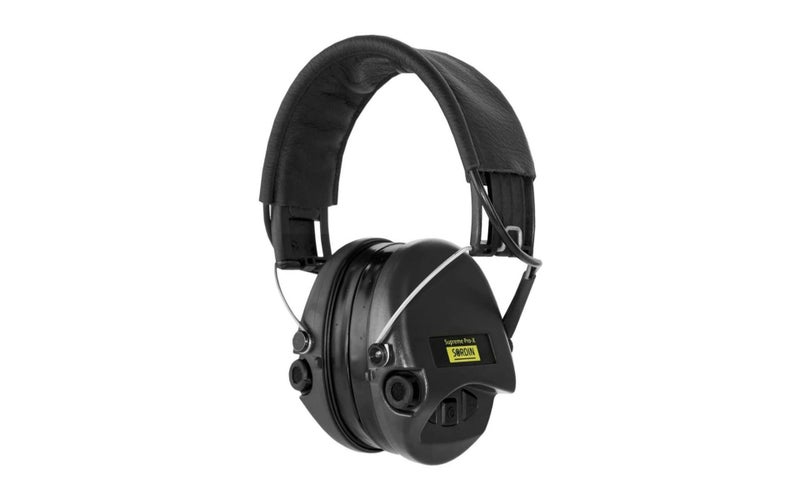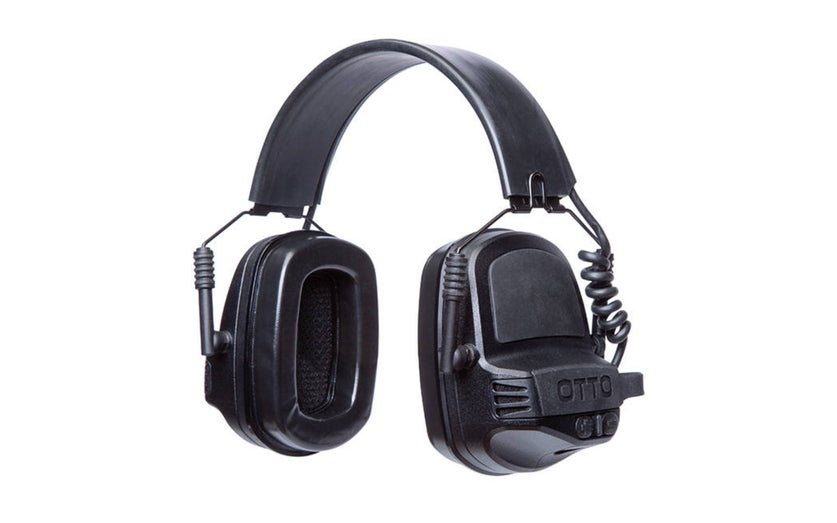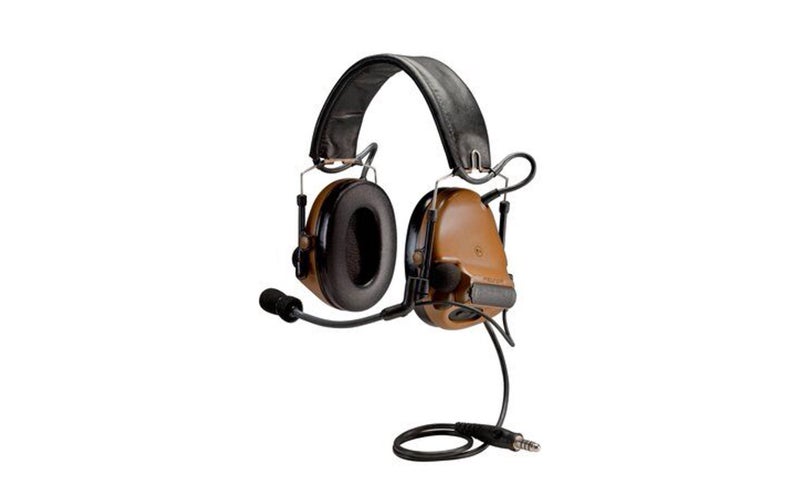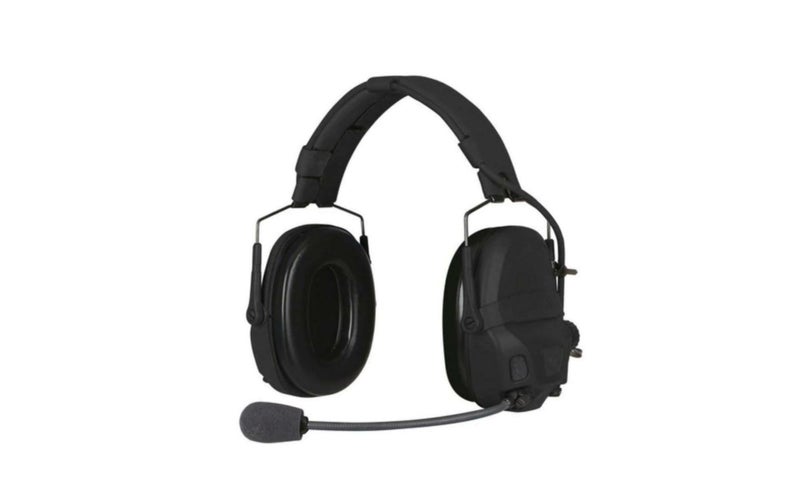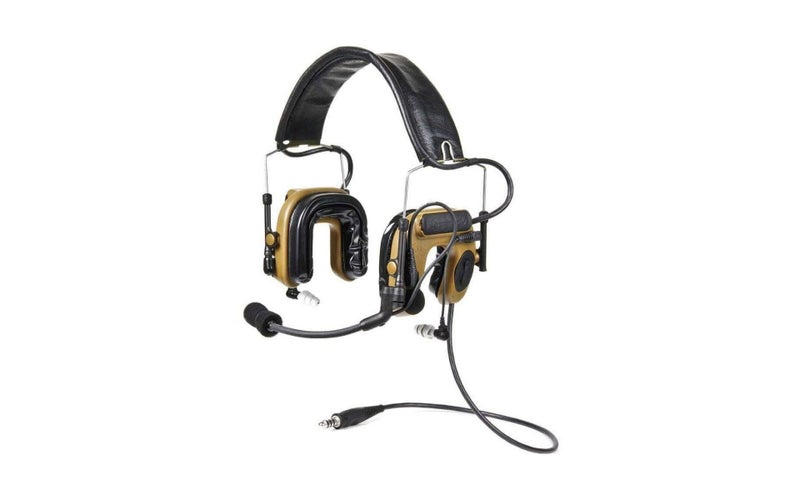We may earn revenue from the products available on this page and participate in affiliate programs.
For years, special operations types have enjoyed powered shooting ear protection that not only shielded their ears from harsh sounds and blast pressure but also provided integrated communications and computer-enhanced bionic hearing. Regular service members often buy their own hearing protection to get in on the cool-guy factor (and save themselves from premature hearing loss). Still, unfortunately, not all options are created equal. On Amazon alone, there are legions of imitators, subpar offerings, and “American-made” headsets that are not officially certified in any way to protect your hearing.
With this in mind, Task & Purpose set out to compile an exhaustive list of the best shooting ear protection on the market, based on professional military usage, sport shooting, and expert opinions. Most powered hearing protection systems feature microphones that playback noise through headphone speakers in real-time, allowing for stereophonic situational awareness of your surroundings while protecting your hearing from damage due to gunshots, explosions, power tools, or even artillery fire. In addition to standard powered hearing protection systems, we’ve included more costly options that allow for integrated communications should you need them for military, first responder, or personal use.
All options on this list were physically evaluated for the purposes of this review and all are officially certified and ready for anything. As a rule, everything on this list is commercially available, so if you don’t see things like TEA Hi-Threats or Invisio X50s it’s because they don’t generally sell to civilians. In addition, there are several obscure options, like the full-size Otto Noizebarriers and Silynx Clarus Pro, and more common options like the Comtac V and VI that we couldn’t test just due to time constraints and availability. Finally, every pair of hearing protection on this list is officially certified to undergo use in high noise environments to include military usage, something prices will reflect accordingly —although it’s cheaper than the medical bills for hearing damage.
- Best Overall: Safariland TCI Liberator HP 2.0
- Best Value: Peltor Sport Tactical 100
- Best In-Ear: OTTO Engineering NoizeBarrier Micro
- Most Comfortable Over-Ear: Sordin Supreme Pro X LED
- Best for the Range: OTTO Engineering NoizeBarrier Range SA
- Best Comms: Safariland TCI Liberator V
- Best Value Integrated Comms: Peltor Comtac III/Comtac ACH
- Most Modular: Ops-Core AMP Communication Headset (Connectorized)
- Best In-Ear Comms: Peltor Comtac IV Hybrid Communication Headset
The Safariland TCI Liberator HP 2.0 might be the first and last pair of powered ear protection that you ever buy, and that’s not hyperbole. For some time now, Tactical Command Industries — now a subsidiary of The Safariland Group — has been quietly purchasing headset shells from Peltor and Sordin, adding their own improved electronics, and selling them under their “Liberator” moniker.
The Liberators IV and V introduced a totally revamped and original design to the market followed shortly by the Liberator HP, which does away with the communications requirement to deliver the same form factor and circuitry at a more competitive cost. The Liberator HP will work for the vast majority of buyers, civilian and military, and due to the flexibility of the system, it can be configured for different scenarios.
The Liberator HP has many features that stand out from the pack, most prominently its three operating modes. Mode 1 offers your typical amplified bionic hearing; Mode 2 offers active noise canceling to prevent ear fatigue in extremely loud environments; Mode 3 suppresses all background white noise such as air conditioning units, generators, and engines, while continuing to amplify human speech through the use of sound processing software.
Mode 1, the amplified bionic hearing, is the cleanest on this list. It lacks a lot of the noisy digitized sound of other systems, but still gives you greatly enhanced hearing. It also does a good job of not amplifying noises like clothes rustling or footsteps on gravel. When I interviewed Safariland employees, they said this is because their system uses a much more modern sound processor than others on the market and gives the muffs better sound quality overall.
Mode 2 is more useful for the Liberator IV and V headsets where you might need to cancel out all outside noise to hear your radio better, but if you feel like using your safety ear pro as noise-canceling headphones to catch a nap, they work for that, too.
Like other pairs of premium ear protection, the Liberator HP comes with gel ear cups that offer a good degree of comfort over plastic-coated foam or other options. One of my favorite features about the Liberator HP is that it can be changed from a standard headband configuration to a neckband, or over to rail adapters for mounting to a high-cut helmet without any modification to the wiring or destruction of the included headband. That isn’t something that you can say about some other options on this list.
I was able to easily remove my pair from the included headband to a neckband under my USMC enhanced combat helmet (ECH). Also, I was just as easily able to use the Safariland Scorpion mounts to attach them to the rails of my Avon N49 high-cut helmet, both in rear and top rail configurations. This flexibility is another huge point in its favor, and increases the service life beyond a single-use scenario, especially in a military context.
Another great feature is that the Liberators are all dual-fuel, meaning they can use either two AAA batteries or one CR123 battery. Additionally, the battery compartment door makes the most sense out of every option on this list. It’s held in place by a large latch that allows for easy removal of the batteries while also maintaining a water-resistant compartment.
To my knowledge, the Safariland Liberator series is the only pair of active hearing protection that is officially tested to its stated noise resistance of 26 decibels by a third party laboratory. Safariland was confident enough in their product to provide me with the official documentation stating this from the lab.
However, even such a magnificent headset has its flaws, as few as they may be. For starters, the Liberators aren’t the slimmest ear muffs on the market. They’re wider than older variants, the Liberators II and III, which used Sordin bodies. Another criticism is that the Liberator HP is unable to connect to a hand mic, which is a common feature for other similar ear muffs. Also, reconfiguring from a headband to a neckband, for example, can be costly. Safariland Scorpion mounts retail for $80 to $100.
Finally, the Liberator HP, as good as it is, feels a bit like an afterthought. Like the Liberator IV and V models, the HP is equipped with two pairs of speakers. This design feature benefits communication headphones because it dedicates one pair of speakers to outside sound and the other to comms sound. That separation delivers greater audio clarity, especially for verbal communication. On the HP model, though, the second pair of speakers aren’t wired to anything.
Bottom line is, nobody’s perfect, but these are still the best non-comms-powered hearing protection for most of the usage scenarios that I can imagine. Whether you plan to use them for military, first-responder, tradesman, or competitive shooting, they offer great features at a competitive price.
- Country of manufacture: USA
- Noise reduction level: 26 dB
- Power source: 2x AAA batteries or 1x CR123 battery
- Colors: Black with red accents, Tan with black accents, Multicam with black accents, or OD Green with black accents
Adaptable mounting
Made in the USA
Dual fuel
The best sound quality on the market
Not the slimmest form factor
Expensive accessories
No comms support despite comms-specific features
As the makers of the famous Comtac line of comms-enabled military hearing protection, Peltor is no stranger to the electronic ear protection market. In many ways, they are to powered hearing protection as Saran Wrap is to cellophane. It’s the brand associated with an entire product category. The staying power of the brand name is so strong that Marines in my unit call their issued hearing protection “Peltors” even though they’re issued Sordin Supremes.
Despite this brand recognition and military heritage, Peltor has made our list in the best budget category with its decidedly civilian entry in their Peltor Sport Tactical line. I tested two pairs of Sport Tacticals for the purposes of this article, and the Peltor Sport Tactical 100s won out by being the best value and having a healthy noise reduction rate. Powered hearing protection doesn’t have to be expensive, and these are still better than non-powered options when it comes to situational awareness.
The most significant feature of the Peltor Sport Tactical 100s is the cost. You’ll find them priced at around $100 at most places, or about $200 less than other premium options. But that doesn’t mean they’re flimsy or subpar. The Sport Tactical line is plenty durable for most leisure shooters, and I’ve even seen at least one case of uniformed personnel using them overseas, which was as much a baffling oddity as a testament to their effectiveness. The Sport Tactical 100s are also plenty comfortable, with adequate cushioning on the earcups for extended wear. They use a volume knob for sound adjustment, which is easy to adjust while using gloves, an important feature that some options costing three times as much don’t afford you.
Of course, at this price point, you’d expect some corners to be cut, and even though I have seen people use these in a military context, I wouldn’t recommend the Peltor Sport Tactical 100s for that. For starters, the hearing protection is adequate for intermittent gunfire from most small arms, offering a noise reduction rate of 22 decibels, but for large caliber weapons, machine-gun fire, and cannons or explosions, these aren’t sufficient. If you must use these, double up with earplugs underneath for safety purposes.
Another cut corner is the sound quality. It’s harsh, hissy, and highly digitized, and forces you to manually set the rate at which the noise suppression allows sound back in, but it’s at least better than not having it at all. Don’t expect any gel cups here, since these are, after all, inexpensive hearing protection. You didn’t want to pay more than $100, this is what you get.
The Peltor Sport Tactical 100 is a solid, inexpensive pair of active hearing protection that does the job for most civilian uses. These are probably a good bet for those who are serious about getting into shooting, but not serious enough to start spending on the military-grade stuff that costs $200 and beyond.
- Country of manufacture: China
- Noise reduction level: 22 dB
- Power source: 2x AAA batteries
- Colors: Gray
Inexpensive
Durable for most leisure shooters
Comfortable
Not suitable for military use
Bare-bones
Manual noise suppression
Over-the-ear shooting hearing protection can get hot during the summer, interfere with some styles of headwear, and, for some shooters with wide heads who are forced to wear low-cut military-issued helmets, become incredibly uncomfortable. The OTTO Engineering NoizeBarrier Micro buds are the solution.
These combat AirPods, designed by off-beat German hearing protection company Otto, beat out the Peltor TEP 200s for the spot on this list simply by having a better charging system and being more user-friendly. If the earmuff style is a bit much for you, these are a good option that you can keep on all day and trust to protect your ears better than almost any other option on this list.
The Noizebarrier Micros come with two completely wireless earbuds and a charging case that shows you how much they’re charged. They are lightweight and slim enough to wear in any scenario and offer an incredible level of sound modulation that’s nearly double the decibel reduction of most of the other options on this list. They’ll fit under any kind of helmet or soft cover, and don’t interfere at all with your cheek weld when firing any weapon I tested, which allows shooters with precision rifles that have large adjustable cheek risers to get their shooting position the same regardless of conditions.
The Micros offer over 28 dB of noise reduction and allow you to wear just these around most loud noises, all while offering crystal clear sound enhancement and filtering. The sound profile on these is about on par with what you’ll get from most of our premium offerings, save for Liberators and AMPs, allowing you to hear not just as you would without these, but a little better, bringing up your surroundings to a steady volume.
The charging case is worth noting. It’s water-resistant and features an LED display that shows you the status of the case’s battery, as well as the batteries inside each earpiece. The Micros have batteries that I was unable to burn out even throughout an entire day’s worth of wear. Some online users claim that the batteries can last 16 hours of constant usage.
The Micros may be among the best in-ear hearing protection out there, but they also have all the limitations that usually affect in-ear hearing protection. For starters, the ear tips tend to be uncomfortable, wear down, or both. I tried mine with both the stock ear tips and Comply Foam ear tips from Amazon. While the Comply tips were more comfortable, they wear down after a month or two of regular usage.
The other issue is that for most users, the earbuds will work their way out from talking, chewing gum, or eating food simply due to the way that your jaw interacts with your ear canals. Essentially, they’ll get squeezed out over time, and if they don’t, things become uncomfortable and can lead to some minor soreness in your ears.
Finally, these are on the pricey side, approaching the cost of some comms-integrated headsets from reliable companies, despite having no provision for any kind of radio or wireless connection. Technically, you can use the Noizebarrier Micro Comms kit, but that amounts to a tube that the user connects to both earplugs to allow you to connect to the audio output of a radio using an acoustic tube, without any sort of microphone provision.
Many of our readers will want something that allows them to have all of the hearing protection of earplugs with the situational awareness of powered earmuffs. The Micros are a bit more niche, but for shooters who find the over-ear options too cumbersome or bulky or that they get in the way of their cheek weld, these are essential. While they might not offer the flexibility for comms of other units, while having the same price as some comms-integrated options, a lot of that expense comes from their smaller form factor.
- Country of manufacture: Thailand
- Noise reduction level: 28 dB
- Power source: Rechargeable integrated batteries, case USB rechargeable
- Colors: Flat Dark Earth
Low profile fits underneath any headwear
Extremely good sound pressure level reduction
Does not interfere with cheek weld with rifles
Can become uncomfortable or loose over time
As expensive as some comms headsets without having any comms
Made in Thailand
Up until recently, MSA Sordins were maligned among U.S. service members. Colloquially derided as “poordins,” they were known for inferior sound quality and difficult mounting capabilities. However, Sordin recently split from MSA to allow the company to re-focus on product development instead of just servicing military contracts. Now, they’re back in a big way with improved audio circuitry, stock gel cups, and a (slightly) improved battery compartment. I have owned three pairs of Sordins, and a variant of these is the standard-issue hearing protection for most Marines at my unit.
The Sordin Supreme Pro X LEDs offer the slimmest profile of any over-the-ear headsets on this list. They won’t interfere with the ear cutouts on many low-cut combat helmets, such as the classic ACH or ECH. The sound quality on these could be described as the most “crisp” on this list, favoring a high-end treble boost, as opposed to the Liberator and Ops Core AMP’s more natural sound. This allows for increased vocal clarity, allowing you to pick out individual voices slightly more easily than you can even with your unaided hearing. The headband uses a plastic ratchet system, connected to the earcups by bent metal struts, which allows you to wear these under a helmet without your fit shifting, unlike with Peltor-style adapters. The left earcup features a small, white LED light in the front pivot post of the left earcup. You can activate it by holding the volume up and volume down buttons, which activates it for three minutes or until deactivated.
The biggest selling point, however, is the outstanding comfort of the Sordins. I’ve worn these things for hours on end, and they clamp firmly to my head without causing the headaches that other options have caused in the past. Their slim profile works as intended when slipped under my ECH, which goes on as conveniently as if I was wearing no hearing protection. The fact that these come stock with gel ear cups now is a plus as well. They’re vastly more comfortable than the older foam options, while still maintaining good sound insulation.
The left earcup also features a 3.5mm aux jack, which allows you to connect these to a push-to-talk hand mic using either a 3.5 to 3.5 cable (included), or a 3.5 to 2.5, as with the Safariland TACT-MIC, which allows you to have radio comms without having a microphone in your face or requiring you to shell out extra for the comms-capable Sordin Supreme Mil headsets. The 3.5 mm jack can also be connected to any standard device with a headphone jack, which allows these to be used for music or a mobile device in a pinch.
As a final historical note, the old-style MSA Sordin Supreme BASIC that I had used a battery compartment where you had to completely remove one of the earcups to install the AAA battery, which was an incredible pain in the ass. The new compartment is a much more conventional steel screw cap, which is far more intuitive.
The biggest issue with the Sordin Supreme Pro X is that the headset is inflexible to a degree where it makes options from Peltor look like the AMPs. If you buy the headband option, you’re stuck with the headband option, and if you buy the neckband option, you’re stuck there as well. If you want to deviate from this, you’ll have to undertake significant destructive modifications to the headset to mount it to a high-cut helmet’s rails.
Then there’s noise reduction. The noise reduction rate of the Sordins is designed around the European Single-Number Rating system, which claims that these have 25 dB of sound pressure level protection. However, by the American Noise Reduction Rate system, these only have 18. Considering that other options, such as the Liberators, offer 26 dB NRR, this number looks very low by comparison. It’s unclear why there’s such a gulf between the two numbers, but it’s an important consideration, especially since 22 dB was sketchily low when the Peltor Sport Tactical 100s were tested. The more “crisp” sound profile means that you’ll likely hear room echoes, creaking floors, and rustling clothes more prominently than with some other options, so if you dislike high, sibilant sounds, you might want to avoid these.
The white LED light is another complaint of mine, given that I seldom use white light on a headlamp in a military environment. A red LED version would be much better for map reading. However, I understand that Sordin may not intend for the Supreme Pro X to be used as a strictly military headset, given that they have a separate military line. The battery compartment has been improved, but the compartment is still a frustrating game of battery Tetris, requiring you to insert the first battery, allow it to drop down into the compartment (or more realistically, force it down with a stick, as I did) and then put the other on top. This is doubly frustrating when it comes time for battery changes, as you have to smack the Sordins around to dislodge the bottom battery, which would be concerning instead of annoying if the Sordins weren’t so rugged.
Yes, the Sordins are back from MSA limbo with a supremely comfortable offering for almost any purpose that, despite its inflexible design, is entirely comfortable straight from the factory. The sound quality is great, the gel cups are a great addition, and it feels like a headset that was specifically designed to be used under my ECH (because, well, it was). It’s worth noting that before making the Liberator IV, V, and HP bodies, Safariland used Sordin bodies for their Liberator II and III models. Overall these are a competitively-priced pair of hearing protection that offers great comfort for most users.
- Country of manufacture: Sweden
- Noise reduction level: 18 dB
- Power source: 2x AAA batteries
- Colors: OD Green, Black, Multicam, Blaze Orange, Orange Hunting Camo
Supremely comfortable
Good sound quality
Slim profile works great with helmets
Frustrating battery compartment
Inflexible mounting options
Low noise reduction rate
Otto Excellence is the middle child of the hearing protection world, often forgotten in a sea of Peltors, Sordins and other brands. These squared-off, unusual-looking headsets were requested by several of our readers, simply because none of them had any idea what they were and wanted to hear our take on them. Additionally, I interviewed Otto sales manager Mike Griffith about what the company set out to do when they introduced the Noizebarrier line. Otto’s work is, in many ways, a radical departure from other brands on this list, but their products work just as well as most of the options from more popular brands like Peltor.
The Noizebarrier Range SAs are the hearing protection-only variant of the Noizebarrier line. The company’s goal, according to Mike Griffith, was to improve hearing in environments punctuated by sudden loud noises, which is the case with most shooting ranges. The Range SAs achive this by having a faster “attack,” which is how fast the sound compression turns on, and a faster “decay,” which is how fast the compression turns off. What this means is that, in between bursts of gunfire, your hearing will return to normal much quicker, preventing the compression from applying to things like human voices and environmental sound and improving your situational awareness generally.
The SAs succeed in providing improved hearing clarity. When I loaned mine to a Marine artillery cannoneer, he reported that the headset suppressed the sounds of the cannons and very little else, allowing him to communicate with his gun crew effectively. Even in the July desert heat of Twentynine Palms they remained surprisingly comfortable, owing in part to the earcups. The choice of using two ball joints on either side of the headset earcup provides great articulation and can alleviate tension headaches from more rigid headsets pressing into your temples for long periods of time.
The biggest area where the Noizebarrier Range SAs suffer most is in the weight department. Even Otto’s representatives admit that their biggest challenge with the headset has been reducing the weight and size, which clocks in at nearly 20 ounces. Another issue is that the noise reduction level of 23dB is right at the threshold that I’d consider acceptable for professional grade hearing protection, especially compared to options like the Safariland Liberator HPs. Finally, the ball joints that they use for the headset mount, while more articulated, have a tendency to pop out when stored, meaning that you have to check them before putting them on.
- Country of manufacture: USA
- oise reduction level: 23 dB
- Power source: 2x AAA batteries
- Colors: Black, Flat Dark Earth
Superior hearing resolution in high noise environments
Comfortable
Highly articulated mounting
Heavy and large
Lower noise reduction rate
Mount joints can pop out
The only reason that the Safariland TCI Liberator V didn’t win best overall is that the majority of users are never going to use all of its features. At nearly $900 retail, that’s a lot to ask for someone who just needs powered hearing protection for shooting at the range. However, the Safariland TCI Liberator V is not only one of the best headsets on the market, but it’s one that I have a lot of (semi) professional experience with, given that a modified Liberator V headset comes with my Target Handoff System (THS) kit that I use as a forward observer in the Marine Reserves. The Liberator V offers all the flexibility of the Liberator HP, now fully realized in a communications headset that will handle just about anything you throw at it.
The Liberator V seeks to fix the issue that a lot of people have with many dual-comm headsets in that it has a Smith’s connection downlead that you can plug into whichever adapter suits your needs at that time. The Marine Corps-issued “JTAC Kit” that comes with my THS includes almost every adapter, and although these don’t come with the Liberator V, you’ll likely end up buying one, depending on your intended use.
The first notable item is the TCI dual comm push-to-talk that features switches on either side of the box, each with a shape on them so you can feel the difference between the two. Additionally, they’re color-coded red and black and have a feature that prevents you from activating both at once. All of this is in service of making this the only TEMPEST RED/BLACK-compatible push-to-talk system on the market, to my knowledge.
What all of that means is that the PTT is set up specifically to avoid the possibility of transmitting the same signal on two separate networks, which can cause a host of problems. These include clogging up the airwaves with junk traffic, breaking segregation between classified (RED) and unclassified (BLACK) networks, or encrypted and unencrypted networks.
That push-to-talk ends in two female U174 plugs that support a variety of adaptors fitted for Motorola radios, standard six-pin MBITR plugs, TP-106 plugs, and even a Bluetooth adapter that allows you to listen to your music or use the headset as a hands-free device for a mobile phone. Additionally, you can bypass the TCI push to talk and get a Smith’s to U174 adapter to use other models of a single-comm push to talk, such as the venerable U94, with the option of using dual comm if needed down the road.
The microphone and downlead are permanently wired into one ear cup from the factory, and these headsets are made to order by Safariland, so when you buy one, you’ll be able to specify which side you want the microphone on and if you plan on using it for civilian or military use. The advantage of doing the wiring and miking from the factory is that the connections will be more durable than removable downleads and microphones, and more water-resistant as well.
In terms of other features, the Liberator V is largely similar to the Liberator HP in terms of having the same stellar sound quality, gel cushions, and flexible mounting systems. You can also specify which mounting option you want from the factory.
Additionally, the Liberator V keeps the dual-fuel battery compartment that accepts both AAAs and CR123s. Mine even comes with a red and green “lip light” built into the microphone, with a switch on the left earcup, set up for easy map reading. The headset is the only one on the market that is completely Radio Frequency and Time-Division Multiple Access PCB-shielded as well, which for the uninitiated means that it’s fortified against types of electronic interference that are common around military and other types of professional radios. As a final note about the sound quality, the Liberator V features two separate speakers in each ear, one for environmental audio and one for radio audio, which prevents the sounds from clashing with each other and muddying the audio.
The Liberator V does have a few issues though, which might be reasons beyond the price to consider not buying them. For starters, the microphone and downlead being hardwired in means that you can’t use these for just hearing protection purposes, at least not without the boom mic in your face.
Additionally, there’s no provision to stow the downlead in a way that makes it easily accessible to connect. The best workaround I’ve found is to tuck it into the velcro keeper on the headband or neckband, which isn’t a solution if you’ve got the Liberator V mounted directly to a helmet. In that case, it may be wise to use the same keepers that I used on the Comtac IIIs.
Another limitation of the Liberator V is that you have to buy them from Safariland directly, given that they are made to order. This is a limitation because civilian buyers will always be paying MSRP for these, unlike with other brands where you may find them at a lower price. As a final limitation, the cost of the accessories is one of the worst parts of Safariland communication headsets. You effectively have to use their push to talk for dual comms, and then you have to use their adapters made for their push to talk. There’s not much of a secondary market.
With its mix of features, flexibility as a system, and superb sound quality, the Liberator V is the best communications headset that I’ve used. For the professional user (or hardcore LARPer), the Liberator Vs provide an outstanding suite of features that will stand up to heavy levels of abuse.
Additionally, if you’re a professional buyer, contact Safariland through your work email for discounted pricing, which will bring you down from that MSRP a bit. Finally, if you want the Liberator V sound quality and flexibility, but are 100 percent certain that you only need single comms, the Liberator IV provides that for a slightly lower price.
- Country of manufacture: USA
- Noise reduction level: 26 dB
- Power source: 2x AAAs or 1x CR123
- Colors: Flat Dark Earth, OD Green, Black
Outstanding sound quality
Flexible mounting and connection options
Durable against physical and electronic hazards
Hardwired mic and downlead
Only Available from Safariland
Connection flexibility limited by proprietary parts and high costs
Peltor Comtac is the most commonly issued comms-integrated powered hearing protection in the U.S. military to the point where every pair of powered hearing protection is known colloquially as “Peltors.” If you’re the kind of person who needs to have at least one radio while also ensuring you won’t go deaf from loud noises, and you’re on a bit of a budget, these are the best options for you.
On the used market, you can’t beat the Comtacs for availability, and spare parts are almost everywhere, ranging from gel ear cups to aftermarket headband covers and adapters to directly mount these to a high-cut helmet. While no longer the bleeding edge in terms of comms-integrated powered hearing protection, the Comtac IIIs are a competent option that you can find on the secondhand market for not too much.
The Comtac IIIs are a truly battle-tested hearing protection option that allows for seamless comms integration with crystal clear transmission and reception. As hearing protection, the Comtac III provides 23 dB of sound pressure level reduction and offers environmental situational awareness with a good degree of clarity. These headphones cost a bit more than the lower-priced Peltor Sport Tacticals mentioned earlier because these are officially certified under various environmental conditions by MIL-STD 810F, including saltwater survivability, meaning that these are truly military-proven headphones that you can trust to use on duty.
The most significant feature of the Comtac IIIs is the “downlead,” or a cable for use with standardized comms push-to-talk units that allow you to have your talk switch on your chest or equipment somewhere and adapt the headset to whichever type of radio that you use. The downlead terminates in a U174 connector, and should you need to use two different radios — say, for a Motorola admin radio and an A/N PRC-152 — you can find Comtac IIIs that have a downlead on each ear cup to connect to two separate push-to-talk units and two separate radios. The microphone can even be removed and the two-pin plug connected directly to a gas mask talk box for use while in MOPP gear, which is essential for people who do sensitive site exploitation in a chemical threat environment. Finally, you can easily mount these to rail adapters to attach directly to a high-cut helmet, and most options on the market are designed for Peltor-style mounting connectors.
The problem with buying older Peltors is that they’re no longer the bleeding edge of technology, but they’re still expensive if you just need hearing protection. The sound pressure level reduction, at 23 dB, is not much when compared to more modern options, and that sound protection can change if you use the arc rail mounts to attach to a helmet, or if you put gel ear cups on.
Additionally, the mounting hardware is comparably miserable. The earcups and the microphone boom are held onto the headband by plastic clips, which are prone to breaking, especially in extreme temperatures or over prolonged use. This problem extends to the two-pin microphone connector, and the clip that the microphone itself connects to, which I’ve personally had break on me. The struts that the ear cup connectors are attached to are held on by friction and slide freely up and down if pressure is applied, which is an issue if you’re wearing these on a headband underneath a helmet. The arc rail adapters for these aren’t much better and tend to pop out randomly after prolonged use, which can be an issue when you’re on the firing line and the guy next to you decided to bring the ear-blaster 9000 muzzle brake. The battery compartments feel cheap and have a tendency to pop out, which leads many users to tape the battery compartment doors down.
Lastly, there’s no included way to manage the cable downloads, which are not removable. On my pair, with two separate downleads, I had to attach elastic loops to the outside of the ear cups with velcro, which I got from Koffin Wurks.
The Comtac III/ACH is the most likely headset for you to find on the secondary market that’s suitable for military use and feature comms capabilities. They’re also commonly used and there are plenty of accessories available for them, so you’ll never have an issue finding spare parts. Despite the particular limitations of this system, it has remained popular in recent years, and I’ve personally used a pair for both shooting hearing protection and radio traffic in the past.
- Country of manufacture: Sweden/USA
- Noise reduction level: 23 dB
- Power source: 2x AAAs
- Colors: Coyote Brown, OD Green, Black
Proven by widespread use
Easily available secondhand
Readily available spare part
Less-than-stellar sound reduction
Widespread durability issues
Mounting solutions are as fragile as the headsets themselves
The Ops Core AMP is a really cool headset. I don’t mean that to say that the other headsets on this list aren’t, but these are so cool that they got featured (uncredited) in 2023s “Battlefield 2042” because of their futuristic appearance. After all, it’s a pair of powered hearing protection that can be mounted to your helmet with what look like robotic claws, and the visual design is a departure from the relatively-similar-looking Comtacs, Sordins, and Liberators on the market. They’re also incredibly modular, with nearly every aspect of them being able to be changed to fit your needs, and once fully set up, they offer very good sound level reduction, although at a very, very steep cost.
The AMPs offer very good sound quality, as well as a headset that can be swapped between mounting modes even more easily than the Liberators. AMPs come mounted to a headband by default but are held on with a set of plastic claws that fit into divots on either end of the earcups. The cable is held captive underneath a velcro cloth headband, which allowed me to swap the ear cups into a helmet-mounted mode in roughly 90 seconds, provided that I already had the rail adapter arms already installed on my helmet.
The AMPs feature an auto-shutdown feature that powers the headset down after two hours of use, and like most comms-capable options on this list, works as a comms headset even without power to the “3D Hear-through” audio, which is their term for the bionic hearing capability that all these headsets have. The sound quality for environmental audio is very clean, with minimal digitization and good spatial awareness, which is essential inside any building that doesn’t have carpeting or upholstery to deaden harsh echoes.
The microphone, which is fully removable and swappable to either side without any tools, is specifically set up to deaden background noise to prevent any radio transmissions that you might send from being drowned out by the wind, car engine noise, or gunfire. The radio downleads, sold separately, are also completely removable without tools, and allow you to configure the AMPs for single comms, dual comms, or no comms based on your needs at the time. Each ear cup also features a screw-cap battery compartment, each housing a single AAA battery.
Finally, for an added boost of hearing protection, if you purchase a near-field magnetic induction-capable pair of AMPs, you can wear special near-field magnetic induction (NFMI) earplugs underneath, bringing the noise reduction rate from 22 dB to 34 dB.
So if the AMPs are the coolest headset on the market, why are they not, say, the best premium option? They’re certainly premium, with a fully-featured set of AMPs costing $1,400, before options like secondary downleads or aftermarket gel cups. A big part of that cost is getting the AMPs to the hearing protection levels that you’d expect from other modern options on this list. To get that advertised 35 dB of noise reduction, you need the NFMI earplugs (add $200) and an NFMI capable headset (add $50). A set of helmet rail mounts is $99.95. A downlead cable is $135. At the very least, for a pair of headphones that offers the noise reduction level of a pair of the Peltor Sport Tactical 100s or Comtac IIIs, you’re paying well over $900.
The NFMI earplugs also present a very unique problem, which is that they give you hearing protection that has all the in-ear discomfort and fitment issues of any other earplug hearing protection on the market. The plastic clip mounting solution for the AMPs also has issues. I had the pair pop free of their mount during normal use, and I’ve seen photographic evidence of these plastic pieces breaking due to impacts or torsion.
The AMP headset is hearing protection for people who need to rapidly and routinely change configurations with very little effort, and who don’t mind paying the cost to do so. Most of the cost issues stem from the fact that to make the removable downleads durable, Ops Core had to use more expensive Smith’s connectors, which are going to naturally cost more than having hardwired downleads.
- Country of manufacture: Variable, Berry Compliant available upon request
- Noise reduction level: 22 dB, 34 with the separately sold NFMI earplugs
- Power source: 2x AAAs
- Colors: Tan 499, Foliage Green, Black, Urban Gray
Outstanding sound quality
Customizable mounting and connection options
Maximum 34 dB of noise reduction
Cost-prohibitive for most users
Fragile mounting clamps
Possible discomfort when used with NFMI earplugs
“What the hell is that?” is the question you’ll likely be getting from those unfamiliar with the horseshoe-shaped animal that is the Peltor Comtac IV. It’s a headset that solves the issue that most in-ear powered communications headsets have, which is where to put the microphone. Some headsets use throat mics, but those can be uncomfortable and don’t provide very good audio clarity. Others use microphones mounted to the outside of the earbuds, but those have similar issues with sound clarity and can cause harsh screeching feedback if not properly calibrated. In addition to solving this, the Peltor Comtac IVs allow familiar helmet mounting using Peltor-style Arc rail adapters, meaning they can be incorporated into someone’s current preferred mounting system. The open-earcup design is excellent for those in hotter environments who need ventilation, while also featuring gel cushions for added comfort.
The Comtac IVs offer vocal clarity that other in-ear communications headsets struggle to achieve, due to maintaining a traditional boom-style mic. This is essential for people who need to transmit critical information over the radio like a nine-line to evacuate a wounded person from a hot zone. Other microphone types struggle to achieve this, such as throat mics or bone conduction, which can muffle sound to a degree that specific words like numbers can become muddled.
In addition, the Comtac IVs don’t require power to function as a radio headset, which other comparable units cannot do. The microphone can also be completely removed, using the familiar Peltor two-pin connector, allowing you to use the Comtac IVs as a pair of powered hearing protection with very little difficulty. Due to lacking the speaker drivers of most powered over-the-ear hearing protection, the Comtac IVs are also surprisingly lightweight, which means less stuff making your helmet more cumbersome. The greatest advantage of the Comtac IVs over more traditional over-ear headsets is that they offer breathability for your ears, which is a godsend in hotter or more humid environments when sweaty ears are a real threat.
Unfortunately, this extremely weird-looking communications and hearing protection option does come with a few significant shortcomings. The first is that usually one of the advantages of in-ear hearing protection is an enhanced level of noise reduction. Unfortunately, the Comtac IVs offer no better hearing protection than the Liberator HPs, which are traditional over-the-ear headsets.
Another key limitation is the fact that these things are a mess of wires. Each earcup (ear-horseshoe?) has its own earbud cable and they’re linked with a cable (which is common), a microphone, and a downlead. All these wires, at least in my case, obscure the power and volume controls, which are also smaller than usual due to the reduced surface area.
As part of this hybrid design, they remove one of the key advantages of in-ear hearing protection as well, which is the ease of use under a low-cut ACH or ECH helmet, as well as zero effect on your rifle cheek weld. Due to having a pseudo-earcup, the Comtac IVs can still be a challenge to wrangle through your helmet straps and can get in the way when using a rifle with a large cheek weld. Finally, they suffer from a lot of the mounting fragility issues that other Peltor headsets face, meaning that the earcups will move up and down freely, and the plastic clips may break.
Bottom line, these are comms-enabled hearing protection that attempts to blend the best of both worlds and is a great option for those who find traditional over-ear hearing protection to be too clammy, but who want comms clarity. Their niche use brings niche issues, but the Comtac IVs offer unique capabilities in a lightweight package and an odd-looking one at that.
- Country of manufacture: Sweden/USA
- Noise reduction level: 26 dB
- Power source: 2x AAAs
- Colors: Coyote Brown
Outstandingly lightweight
The best blend of breathability and microphone clarity
Familiar package
A mess of wires
Fragile mounting clamps
Noise reduction is the same as some over-ear options
Why you should trust us
For this article, I sought out every variant of hearing protection and powered headset that I could find to get an exhaustive list of most of the trusted variants on the market today.
In addition to having years of experience with powered hearing protection, and taking every set on this list either to the field or to the firing range, I interviewed sales representatives and product developers from many of the companies that make these products via email or over the phone. Safariland in particular provided Task & Purpose with complete technical documentation from their safety certification testing procedures carried out in a third-party lab.
In terms of communications headsets, I’m a stickler for good-quality headsets, given the importance of clear communication in any sort of professional environment, and so I evaluated the comms-capable headsets using a civilian radio that offered six-pin MBITR connector capabilities so that I could test these with their intended push-to-talk units. Finally, I tested these under a range of headwear to ensure that I could adequately comment on their comfortability.
Types of shooting ear protection
Shooting ear protection comes in four major categories: unpowered earplugs, unpowered earmuffs, powered in-ear, and powered over-the-ear, also known as “circumaural” hearing protection. These options bring their specific capabilities to the table. In general, unpowered hearing protection will be cheaper and can be a good option for doubling up on hearing protection in high-noise areas, such as those on a flight line or near loud explosions. In terms of powered hearing protection, over-the-ear will generally be cheaper than in-ear options, as the latter requires more complicated and small circuitry to function.
Unpowered earplugs
Unpowered earplugs are the shooting hearing protection most people are familiar with. They usually come in the form of shapeable foam earplugs and are often inexpensive (in fact, most ranges give them out for free). However, these can range from “foamies” to options like the Surefire Sonic Defenders, and specialized musician’s earplugs that lower the overall sound level without muffling the sound, which allows you to still have some clarity to your hearing even with these on.
These are a great option for those who want to double up under a powered headset, which is something I commonly see people on flight lines do, or the cannoneers at my unit, standing next to their M777A2 howitzers. Additionally, many shooters prefer these because they do not disrupt your cheek weld at all when shouldering a rifle. Unfortunately, these have issues with coming loose or popping out for some people and can get lost easily due to their small size.
Unpowered earmuffs
Unpowered earmuff-type hearing protection provides a more secure level of hearing protection than unpowered earplugs. They’re quicker and easier to take on and off and require none of the fidgeting needed to stick earplugs in. In general, these offer similar sound reduction levels to earplugs, but some can even rival high-end earplugs with noise reduction rates of 30 dB or more. The downside to these is that they can be bulky, and prevent you from hearing, muffling nearly everything and offering no real specialized options to allow some sound in, but not others.
Powered in-ear
Powered in-ear hearing protection is an option for people who hate sweaty ears. They allow you to be aware of your surroundings without having to use cumbersome earmuffs. In general, these will be more expensive, due to the smaller circuitry needed to provide the ambient hearing features in such a tiny package.
Additionally, many have higher noise reduction rates than powered over-the-ear headsets, due to their use of multi-flanged or other specialized ear tips, which allow them to physically block sound better. They offer the same ease of use as unpowered earplugs but also the same drawbacks.
Powered over-the-ear
Powered over-the-ear hearing protection is what most people think of when they think of powered hearing protection, given the popularity of options like Peltor Comtacs. They offer auditory situational awareness while offering much the same fit as conventional earmuffs. They’re generally the go-to option for communication headsets as well, offering both hearing protection and a convenient way to communicate via radio. Many of them can be mounted to a high-cut helmet for easy wear, and some even offer options to readily switch between headband, neckband, and helmet mount configurations. The downside to these is that like conventional earmuffs, they can get very hot in the summer months, which can lead to user discomfort.
Key features of shooting ear protection
Decibels
A decibel is a measure of sound that gauges the energy of a sound wave on a logarithmic scale. What this means in layperson’s terms is that a sound that is 80 decibels isn’t one louder than something that is 79 dB, but rather 800 times louder than a sound that is 0 dB. Every time the number increases by 10, that’s a tenfold increase over the previous factor of 10.
Additionally, a 3 dB increase doubles the perceptible sonic energy and can be immediately noticeable and the difference between prolonged and immediate hearing damage. Some key sound pressure levels to know are normal speech (60 dB), most gas-powered leaf blowers (80dB), loud amplified music (110 dB), the threshold of instantaneous hearing damage (120 dB), many gunshots (130-145 dB) and a space shuttle taking off (170 dB). So a gunshot is 1,300 times louder than the quietest sound that people can hear.
Noise Reduction Rate (NRR)
Noise Reduction Rate is the U.S. standard for measuring how much the energy of a sound wave is reduced by a hearing protection device measured in decibels. This number tells you how much the hearing protection in question will protect your hearing and should be considered alongside the noise levels you intend to work with.
‘Hear through’ capability
One of the key reasons to use powered hearing protection is the “hear through” capability. Known by many other names, hear-through allows you to semi-naturally perceive your surroundings as if you had your ears uncovered by using microphones on the outside of the headphones, which simulate your ear canals. Powered hearing protection will have at least one microphone on each ear. However, more recent and more advanced versions like the Peltor Comtac VI have microphones on the front and back of each earcup. One of the most important aspects of hear through capability is that it compresses the human hearing spectrum down to a relatively narrow span of decibels, so that loud noises are much closer to quiet sounds and do not damage your hearing. Older hearing protection, as well as the vast majority of inexpensive copycat ear protection on sites like Amazon, will simply cut out the audio for a split second every time that there’s a loud noise, which is not preferable.
Benefits of shooting ear protection
Increased situational awareness
By using the hear-through capability found on powered hearing protection, you don’t have to sacrifice situational awareness while protecting your ears, allowing you to carry on conversations, hear movement around you, and generally have good spatial perception based on sound.
Long-term comfort
Good quality hearing protection will feature comfort-enhancing items such as gel earcups, padded headbands, and ergonomically formed designs so that you won’t feel tempted to do without your hearing protection in the name of comfort.
Comms capability
Many of the higher-end hearing protection on this list offer comms integration, which means that they can be used as a radio headset. Rather than having to hold a hand mic up to your head next to the hear through microphone, or pushing your hearing protection away for a second to listen in, they allow you to have hearing protection that maintains situational awareness and radio clarity without sacrificing safety.
Pricing considerations for shooting ear protection
Low-end
Low-end hearing protection will generally either be unpowered or powered by primitive circuitry that lacks a lot of the creature comforts of higher-end models. At this price point, you’ll likely find a lot of low-quality Chinese-made copies of higher-end headsets such as Comtacs or AMPs, and these are not safe to use for any sort of serious shooting use.
Mid-range
This is where you’ll find many of your no-comms options and some used comms options. Generally, these will be of great quality, designed specifically to be used as hearing protection in a tactical or professional environment. This is where to aim if you’re a serious shooter and want hearing protection that will last you years.
High-end
Professionals and LARPers only! High-end hearing protection is aimed squarely at the military and tactical law enforcement market, often designed to withstand severe damage and rough use and usually featuring some sort of comms integration. These will be executed to a very high level of finishing, generally, and usually feature some highly innovative features.
How we chose our top picks
Out of the myriad headsets that we evaluated, we distilled our selections down to our best overall, best budget, and best in-ear to capture the three major requirements that many shooters have for their hearing protection. We want to serve those who want to buy once and cry once, those who are on a budget, and those who live in extremely hot or humid environments or have other special considerations that would require them to have in-ear hearing protection. All of these options were tested by wearing them for prolonged periods, taking them to the range, and interviewing long-term users and subject-matter experts. The other options on this list are no less curated, they just fit into a much more niche capacity and therefore aren’t going to be right for everyone.
FAQs on shooting ear protection
You’ve got questions, Task & Purpose has answers.
Q: Are ear muffs better than earplugs?
A: Generally, un-powered earmuff style hearing protection can offer more sound protection than simple earplugs. However, in terms of powered hearing protection, the opposite is usually true, just due to how they seal the ear from sound and the requirement for the powered hearing protection to have hear-through capability.
Q: What is the best ear protection for shooting ranges?
A: Most hearing protection will work for outdoor ranges since the open air and lowered risk of gunshots reverberating make them generally quieter. However, if you shoot primarily indoors, the Safariland Liberator HP offers a very high, officially tested sound protection level that will protect your ears from reverberating gunshots in a confined space.
Q: What is the highest dB reduction level for earplugs?
A: Generally, most earplugs have a noise reduction rate that tops out in the low 30s, which is much higher than many powered hearing protection options can offer. However, this can be enhanced by doubling up, or by using powered hearing protection that offers active noise canceling, such as the Liberator HPs, which aren’t earplugs.
